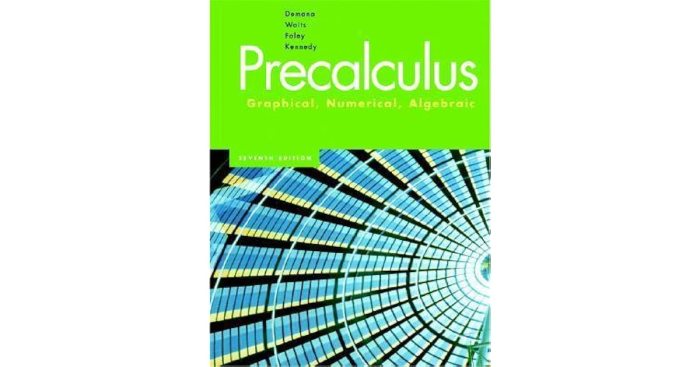Precalculus graphical numerical algebraic answers provide a comprehensive foundation for understanding the intricate world of mathematics. By delving into the depths of graphing, numerical methods, and algebraic principles, precalculus empowers students to unravel complex functions, analyze data, and solve equations with precision and confidence.
Precalculus serves as a cornerstone for higher-level mathematics, engineering, and science. Its concepts are essential for comprehending the dynamics of the physical world, from the trajectory of projectiles to the behavior of electrical circuits. This introductory paragraph piques the reader’s curiosity and sets the stage for an engaging exploration of precalculus graphical numerical algebraic answers.
Precalculus Graphical Analysis: Precalculus Graphical Numerical Algebraic Answers
Graphical analysis in precalculus involves representing functions as graphs on a coordinate plane. It allows us to visualize the behavior of functions, identify their key features, and make predictions about their values. By graphing functions, we can gain insights into their domain, range, intercepts, asymptotes, and critical points.
Different types of functions, such as linear, quadratic, exponential, and trigonometric functions, exhibit distinct graphical patterns. Understanding these patterns is essential for analyzing and interpreting functions in various contexts.
Techniques for Analyzing Graphs
- Finding intercepts: Intercepts are points where the graph crosses the x-axis (y-intercept) or y-axis (x-intercept).
- Determining asymptotes: Asymptotes are lines that the graph approaches but never touches, indicating infinite behavior.
- Identifying critical points: Critical points are points where the graph changes direction, indicating potential extrema (maximum or minimum values).
Numerical Analysis in Precalculus
Numerical analysis in precalculus employs numerical methods to approximate solutions to precalculus problems. These methods are particularly useful when analytical solutions are not readily available or are computationally intensive.
Numerical techniques include using tables to create graphical approximations and employing graphing calculators to visualize functions and find approximate values.
Advantages and Limitations of Numerical Methods, Precalculus graphical numerical algebraic answers
- Advantages:
- Applicable to a wider range of problems.
- Can provide approximate solutions when analytical solutions are difficult or impossible.
- Limitations:
- May not always provide exact solutions.
- Accuracy depends on the number of iterations or precision used.
Algebraic Analysis in Precalculus

Algebraic analysis in precalculus involves using algebraic concepts and techniques to solve problems and manipulate expressions. These concepts include factoring, solving equations, and manipulating expressions.
Factoring is the process of expressing a polynomial as a product of simpler factors. Solving equations involves finding the values of variables that satisfy a given equation. Manipulating expressions involves simplifying and transforming expressions to make them easier to solve or analyze.
Importance of Algebraic Reasoning
- Algebraic reasoning is essential for solving a wide range of precalculus problems.
- It provides a systematic and logical approach to problem-solving.
- It helps develop critical thinking and logical reasoning skills.
Applications of Precalculus
Precalculus concepts find widespread applications in various fields, including science, engineering, and everyday life.
In science, precalculus is used to model physical phenomena, such as motion, growth, and decay. In engineering, it is used to design and analyze structures, circuits, and systems. In everyday life, precalculus is used to solve problems involving finance, statistics, and optimization.
Real-World Examples
- Using exponential functions to model population growth or radioactive decay.
- Employing trigonometric functions to analyze periodic phenomena, such as tides or the motion of planets.
- Applying algebraic techniques to solve optimization problems, such as finding the maximum profit or the minimum distance.
Key Questions Answered
What is the significance of graphing in precalculus?
Graphing in precalculus provides visual representations of functions, enabling students to analyze their behavior, identify key features, and make predictions.
How do numerical methods complement algebraic techniques in precalculus?
Numerical methods, such as using tables and graphing calculators, offer approximate solutions to problems that may be difficult to solve algebraically. They provide valuable insights and help students develop a practical understanding of mathematical concepts.
What are the key algebraic concepts used in precalculus?
Precalculus relies on fundamental algebraic concepts such as factoring, solving equations, and manipulating expressions. These techniques are essential for simplifying complex expressions, finding solutions to equations, and understanding the structure of functions.